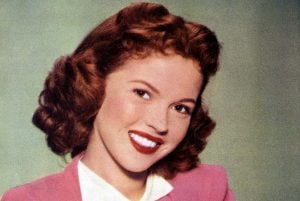See young Joan Crawford showing her good side
Born Lucille Fay LeSueur in 1904, Crawford got her start in show business as a chorus girl before landing a contract with MGM. The studio initially cast her in bit parts, but by the late 1920s, she was making a name for herself in flapper roles that captured the spirit of the Jazz Age. She had a knack for playing lively, fashionable young women, and audiences took notice. One of her standout roles was in Our Dancing Daughters (1928), where she played a carefree socialite whose charm and energy lit up the screen.
In these early years of her career, Crawford showcased a range of talent and charisma that would pave the way for her success in the years to come. Despite her later reputation as a formidable and controversial figure, the young Joan Crawford was a breath of fresh air on the silver screen.

By the end of the decade, Crawford had become one of the most photographed actresses in Hollywood. Studios promoted her as the ideal modern woman — glamorous, independent and stylish. Photoplay magazine even called her “Hollywood’s best photographic subject.” But Crawford was more than just a pretty face. She worked tirelessly to refine her acting skills, determined to prove she was more than a dancer with a dazzling smile. She made the transition to talking pictures with Untamed (1929), showing that she could hold her own in the new era of sound films.
Crawford’s early years in Hollywood weren’t always easy. She later admitted to struggling with insecurity, feeling the need to work harder than anyone else to succeed. But that drive paid off. By the early 1930s, she had solidified her status as a top box office draw, paving the way for a decades-long career filled with iconic performances.
We’ve gathered some incredible photos and vintage articles from Crawford’s early years, showing her rise from a young Hollywood hopeful to a leading lady. Take a look back at the glamorous and ambitious beginnings of one of cinema’s most enduring stars.
Looking back at her early career: Joan Crawford tells all in book (1962)
By Bob Thomas in Hollywood – Lancaster New Era (Pennsylvania) July 6, 1962
Writing of her early years in the movies, Joan Crawford comments: “Maybe I did play harder than anyone else — I worked harder, too.
“Perhaps it was because I had such an inferiority complex, because I was trying to compensate for all I lacked in education, poise and background. I wanted something out of life, and this was the only way I knew to acquire it.”
This helps to explain the phenomenon of Joan Crawford, which is described in depth in her new autobiography, “Portrait of Joan,” written with Jane Kesner Ardmore.
It is an arresting study of the longest-lasting of all the Hollywood stars — she made her first film in 1925, is starring in three this year.
ALSO SEE: 120+ gorgeous, glamorous actresses of the 1920s
The book is in Crawford style — realistic, down-to-earth, but with overtones of glamor and sentiment. That sounds paradoxical, I know, but Crawford is a paradox; a hard-driving woman who manages to remain feminine; a dream merchant with her eyes wide open.

She tells all, or almost all, about the ups and downs of her career and marriages. About the husbands:
No. 1, Douglas Fairbanks Jr: “Douglas was trying to prove something, that he was as good a man as his father, that he was a wit, a practical joker in his own right.
“He didn’t have to prove this to me. I was his best audience, but that wasn’t enough, he needed a larger audience, and entertaining constantly, he’d dispel his energy. When the guests would leave, alas, we were without communication.”
No. 2, Franchot Tone: “There was never a doubt in my mind that Franchot’s talent was greater than mine, and I tried very hard to give him more scenes, to build his ego. It just didn’t work. It was no wonder that he gradually broke away, tried to assert himself.
“He was working in a film, I wasn’t. One afternoon I dropped by his dressing room to surprise him. I did.”

No. 3, Phillip Terry: “I had never really known Phillip, I realized that. I had not really loved him. I don’t like pauses, and this pause ended in divorce. Never marry out of loneliness. I owed him an apology from the first.”
No. 4, Alfred Steele: “For the first time in my life, a man was giving me emotional stability. We attained a precious height — the ability to love each other beyond the love of self.”
Joan also tells about her relations with stepmother-in-law Mary Pickford: “Mary and I became friendly after my divorce from Douglas. But during the time of that marriage, we never had a word of conversation, save in a group of people.
“Newspaper columnists harped on the fact that Mary couldn’t tolerate the idea I might make her a grandmother, but I’ve no idea whether or not that was true.”
She also tells of a love affair with Clark Gable at the time he was married to his second wife: “We talked of marriage, of course. But I dared not ruin the dreams. I’d rather live with them unfulfilled than have them broken.”

Joan describes Gable’s sadness after the death of Carole Lombard. She asked him to drop by her house for a drink one night and he stayed and talked for hours.
He visited her every day for four or five months and talked moodily. Finally she told him: “You’re living in the past. You have a guilt complex because you didn’t go with Carole on that trip. You couldn’t go, you were working! You’ve had your grief, Clark now pull yourself out of it.” Gradually he did, she added.

Young Joan Crawford no longer just a dancing girl (1927)
Cinema astrologers say that this star is in the ascendant. Not too long ago, Joan Crawford was merely a dancing girl with ornamental legs. Recent pictures prove that she is acquiring a vivid and distinctive quality in her acting.

Flapper Joan Crawford in 1928
In 1928, the young actress Joan Crawford was just 23 years old, and on the verge of making her first “talkie” film, Untamed (from 1929).
“Joan Crawford is doubtless the best example of the flapper, the girl you see in smart night clubs, gowned to the apex of sophistication, toying iced glasses with a remote, faintly bitter expression, dancing deliciously, laughing a great deal, with wide, hurt eyes. Young things with a talent for living.” – F Scott Fitzgerald
MORE: 25 vintage dresses from the Roaring 20s that would fit right into the Great Gatsby

Dancing daughters (1928)
Dorothy Sebastian, young Joan Crawford, and Anita Page in Our Dancing Daughters movie as flappers

MORE: 120+ gorgeous, glamorous actresses of the 1920s
Joan – Hollywood’s best photographic subject (1928)
Joan Crawford goes more Spanish than the Spaniards themselves. Joan is Hollywood’s best photographic subject. Not only has she an almost perfect figure — as discovered by PHOTOPLAY — but she has a camera-proof face.
Joan is now tied with Clara Bow as being the most engaged person in the film colony. It’s a penalty these young girls pay for being interesting, vivid and popular.

Blonde young Joan Crawford (c1930)
Blonde Joan in a pretty frock way down to her dancing toes is our best ad for marriage and stardom. She has been called the Venus figure of the screen and that’s flattery for Venus.
She has danced in many a nightclub and in many a picture, and still dances — but mostly for joy. “The Mirage” is her next adventure in giving delightful reality to ethereal visions

John Mack Brown with young Joan Crawford in the never completed movie Great Day (1930)

Joan, sexed up for MGM
Is this the future Joan Crawford? First they said she was a model wife and knitted hooked rugs. And now they’re telling her, “Get hot, Joan, get hot.”
M-G-M has decided that Joan must be sexed up, and this is the first movement in the campaign. You’ll see the new Joan Crawford in “This Modern Age,” and she’ll be blonde-haired and pashy.

Joan Crawford in the revolving door from Grand Hotel (c1932)
A modernistic charmer in a modernistic gown deserves a modernistic setting — and what could be more so than the entrance to “Grand Hotel”?
So Joan visits the scene of her next-to-last triumph — before changing into the flashy garb of Sadie Thompson, the tortured heroine of “Rain,” who is no better and no worse than the reformer who tries to change her. Another big role!

Crawford in 1933
No, Joan hasn’t gone back to taking life and herself so seriously as she used to. Her European vacation gave her a shining new outlook, as we told you last month. Photographer Hurrell varied his formula this time and instead of “Look pleasant, Miss Crawford,” he said, “Look dramatic, look brooding, look interesting!” And doesn’t she?

DON’T MISS THIS: About Greta Garbo: The legendary actress and 20th century icon




















One Response
She may have been attractive early on, but as time went by the ugly got worse and worse, all the way down to the bone. And the way she treated her children was horrible. Overall, just a bad person.